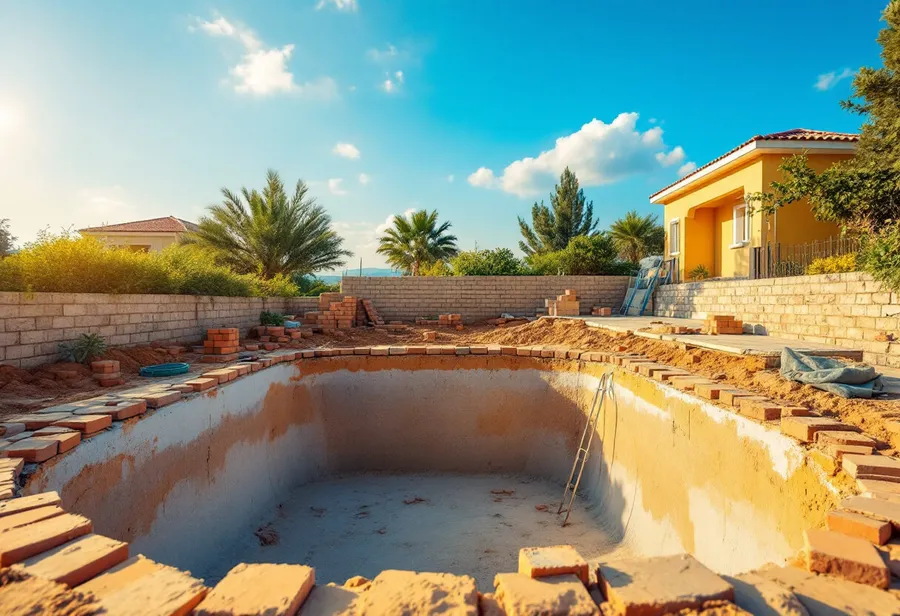Construction planning and scheduling: a complete guide


Introduction
Whether you’re building a new home, adding a terrace, or renovating your house, a construction project is a major undertaking. This guide provides a clear roadmap for construction planning and scheduling, helping you navigate the process with confidence.
1. Why construction planning matters
1.1 From vision to reality
Effective planning is the foundation of any successful construction project. It translates your vision into a concrete plan that guides every decision.
- Define your vision: Begin by outlining what you want to achieve. Are you aiming for a modern open-plan living area, a functional terrace, or a comprehensive home renovation? For specific projects like building a swimming pool or laying a patio, detailed planning becomes even more crucial.
- Establish clear objectives: A written list of goals ensures that your architect, builders, and other stakeholders understand your expectations, which minimizes misunderstandings.
- Align with reality: Planning aligns your vision with practical constraints like budget, timelines, and building codes. This crucial step helps prevent costly changes and disappointment later on.
1.2 Saving time and money
Thorough planning directly impacts your project’s bottom line.
- Prevent costly errors: A detailed plan helps anticipate challenges like design modifications, material shortages, or construction mistakes, addressing them before they escalate into expensive problems.
- Optimize resource management: Strategic planning ensures materials are procured in correct quantities and delivered on time, minimizing waste and storage costs.
- Improve time efficiency: A well-defined schedule sets realistic deadlines and coordinates tasks, keeping the project on track and avoiding costly delays.
2. Getting started with your construction project
2.1 Defining your project scope
The first step is to clearly define what you want to achieve.
- Assess your needs: Analyze how you currently use your space and what improvements you need. Are you accommodating a growing family, creating a dedicated home office, or improving your outdoor living area?
- Create a detailed wishlist: List all the features you want, including room layouts, material preferences, and specific finishes or styles.
- Prioritize your requirements: Differentiate between “must-have” features and “nice-to-have” additions. This helps you make budget-conscious decisions without sacrificing core needs.
2.2 Setting a realistic budget
A well-defined budget is critical for managing your project’s scope and financial health.
- Research and estimate costs: Investigate the average costs for similar projects in your area. Your budget should account for materials, labor, design fees, and permits.
- Account for all expenses: Include fees for architects, engineers, and surveyors. Also, budget for landscaping, furnishings, and potential temporary accommodation costs.
- Secure your financing: Determine how you will fund the project, whether through savings, a home equity loan, or a construction loan. Consulting a financial advisor is recommended.
- Establish a contingency fund: Allocate an additional 10-20% of your total budget for unforeseen expenses. This buffer is essential for managing unexpected issues without financial stress.
3. Finding the right construction company
3.1 The importance of hiring professionals
Partnering with a reputable construction company is vital for a successful outcome.
- Access to expertise: Professional builders provide technical knowledge and years of hands-on experience, navigating the complexities of construction from structural engineering to code compliance.
- Ensured quality: Skilled professionals deliver high-quality craftsmanship, ensuring the safety, durability, and value of your home.
- Effective project management: A reliable company manages all project aspects, including scheduling subcontractors, procuring materials, and maintaining timelines.
- Regulatory compliance: Experienced builders are knowledgeable about local regulations and permit requirements, minimizing the risk of legal issues and delays.
Whether you need comprehensive construction services for new builds, renovation services for existing properties, or ongoing property management to maintain your investment, working with experienced professionals ensures your project’s success.

3.2 How to choose a construction company
Selecting the right builder requires due diligence.
- Research local companies: Identify builders who specialize in projects like yours, whether it’s new construction, renovations, or extensions.
- Verify credentials: Ensure the company is licensed, insured, and bonded. This protects you from liability and ensures they adhere to professional standards.
- Check references and reviews: Look for feedback from past clients. Ask for references and contact them to discuss their experience with the builder.
- Review their portfolio: Examine past projects to evaluate the quality of their work and determine if their style aligns with your vision.
- Conduct interviews: Meet with your top candidates to discuss your project. Ask about their process, communication methods, and how they handle challenges.
- Compare detailed quotes: Obtain itemized quotes from several companies. Don’t base your decision on price alone; consider the overall value, including experience and quality.
Wheter you have a clear vision or need guidance to bring your ideas to life, Buildify is here to help. Let’s collaborate to create something extraordinary.
4. Designing your dream space
4.1 Collaborating with architects and designers
Design professionals translate your ideas into detailed, actionable plans.
- Share your vision: In your initial consultations, provide your wishlist and project goals. A good designer will offer creative solutions you may not have considered.
- Understand the design process: The process typically moves from initial sketches to detailed drawings and finally to construction documents, which are required for permits and construction.
- Balance aesthetics with function: Professionals help you create a space that is both beautiful and practical, considering traffic flow, natural light, and usability.
- Select the right materials: Architects and designers can guide you toward materials that fit your aesthetic, budget, and performance requirements.
Professional architectural design services can provide comprehensive solutions including custom home design, 3D modeling and visualization, and sustainable building design to bring your vision to life.
4.2 Planning for the future
A well-designed home should adapt to your needs over time.
- Incorporate sustainable design: Use eco-friendly features like energy-efficient windows, high-performance insulation, and renewable energy sources to reduce long-term operating costs.
- Apply universal design principles: Make your home accessible for all ages and abilities with features like step-free entries, wider doorways, and reinforced walls for future grab bars.
- Create flexible spaces: Design rooms that can serve multiple functions, such as a home office that can also be a guest room.
- Integrate technology: Plan for smart home features during the design phase. Pre-wiring for automated lighting, security, and climate control is more cost-effective than retrofitting.
5. Navigating permits and regulations
5.1 Understanding local building codes
Familiarity with local building codes is essential before starting construction.
- The role of building codes: Codes exist to ensure safety and health, setting minimum standards for structural integrity, fire safety, and energy efficiency.
- Avoiding legal penalties: Non-compliance can result in fines, work stoppages, or demolition orders.
- Key regulations in Cyprus: In Cyprus, municipal authorities enforce national building laws. These often include rules on building height, property setbacks, and architectural styles in designated zones.
5.2 The permit application process
Securing permits is a critical step that must be factored into your project timeline.
- Required documentation: Applications typically require architectural plans, structural calculations, and sometimes environmental impact assessments.
- Submission and review: Permits are obtained from local municipal offices. Ensure all forms are accurate to avoid delays. Your architect or builder can typically manage this process.
- Timeline for approval: The approval process can take anywhere from a few weeks to several months, depending on project complexity and the local authority’s efficiency.
- Construction inspections: Authorities will conduct inspections at key project stages to verify compliance with approved plans and building codes.
- Permit fees: Budget for application fees and be prepared for potential additional costs if the authorities require design modifications.
6. Creating a construction schedule
6.1 Breaking down the project into phases
A detailed schedule provides clarity and keeps the project on track.
- Pre-construction: This phase includes site preparation, such as land clearing and utility setup, followed by foundation work, which is crucial for structural stability.
- Key construction milestones:
- Framing: Erecting the structural skeleton, including walls, floors, and the roof.
- Systems installation: Installing plumbing, electrical, and HVAC systems.
- Insulation and drywall: Adding insulation for energy efficiency and soundproofing, then hanging drywall to form interior walls.
- Exterior finishes: Applying roofing, siding, windows, and doors.
- Interior finishes: Installing flooring, cabinets, countertops, and fixtures, followed by painting.
- Landscaping: Finalizing driveways, walkways, and garden areas.
6.2 Setting realistic timelines
Effective time management is essential for a smooth construction process.
- Factors influencing duration: Be aware of potential delays from weather, material availability (especially for custom orders), and labor scheduling.
- Incorporate buffer time: A contingency period in your schedule provides flexibility to handle unexpected issues without derailing the entire project.
6.3 Staying on track
Consistent monitoring and clear communication are vital for adhering to the schedule.
- Hold regular progress meetings: Schedule weekly check-ins with your project manager to review progress and upcoming milestones.
- Be responsive: Address issues and make decisions promptly to keep the project moving.
- Use project management tools: Many companies use software with client portals to track progress. A Gantt chart is also a useful tool for visualizing the project timeline.
7. Tips for a smooth home renovation
7.1 Living on-site during renovations
If you plan to live in your home during the renovation, careful planning is essential.
- Phase the work: Renovate one area at a time to create a livable zone away from the primary construction.
- Prioritize safety: Seal off construction zones to control dust and debris and ensure the safety of your family.
- Manage disruptions: Discuss work hours with your contractor to minimize noise and other disturbances to your daily routine.
7.2 Balancing preservation and modernization
When renovating, you can update your home while retaining its original character.
- Harmonize old and new: Preserve architectural features like original moldings or floors while introducing modern elements that complement the existing style.
- Consider incremental renovations: Staging renovations over time can make the project more manageable and affordable. Address structural and functional needs first.
- Consult specialists: For historic homes, an expert in preservation can offer valuable guidance. You can also upgrade energy efficiency with modern insulation and windows without compromising the home’s character.
8. Budgeting and managing costs
8.1 Understanding cost drivers
Knowing what influences your project’s cost helps you make informed decisions.
- Material choices: While high-quality materials may have a higher upfront cost, they often provide better long-term value and durability.
- Labor expenses: Skilled labor is a worthwhile investment that ensures quality craftsmanship and reduces the likelihood of costly errors.
8.2 The importance of contingency planning
A contingency fund is a critical component of a responsible construction budget.
- Allocate a reserve fund: Set aside 10-20% of your budget for unexpected costs. This provides peace of mind and financial flexibility.
- Anticipate common surprises: Unexpected expenses often arise from discovering hidden issues (like outdated wiring or water damage) or making voluntary upgrades during the project.
- Maintain clear financial oversight:
- Ensure your contract clearly details all costs and payment terms.
- Track all expenses against your budget.
- Discuss any potential cost overruns with your contractor as soon as they arise.
9. Quality control and final touches
9.1 The value of regular site visits
Your active involvement helps ensure the project meets your standards.
- Stay engaged: Schedule regular walkthroughs with your contractor to monitor progress and ask questions.
- What to look for:
- Workmanship quality: Inspect finishes, installations, and overall build quality.
- Adherence to plans: Verify that the work aligns with the architectural drawings and specifications.
9.2 The final walkthrough and project completion
Before final payment, conduct a thorough inspection to confirm all work is complete.
- Create a punch list: Walk through the entire project and create a detailed list of any defects, incomplete tasks, or items requiring adjustment. Review this list with your contractor and agree on a completion timeline.
- Understand warranties and maintenance:
- Review all warranties for materials and workmanship.
- Ask your contractor for maintenance instructions for new systems and finishes.
- Gather all documentation: Collect all final certificates, permits, and manuals. Organize these documents with your contracts and receipts for future reference.
- Settle final payments: Release the final payment only after all punch list items are completed to your satisfaction, as per your contractual agreement.
Conclusion
A construction or renovation project is a significant undertaking, but with careful planning and management, it can be a rewarding experience. This guide has walked you through the essential stages, from defining your vision and budget to hiring professionals, navigating regulations, and overseeing the work.
With the project complete, you can take pride in the functional and beautiful space you have created. Proper planning is the key to a successful outcome, and continued maintenance will ensure your home remains a source of enjoyment for years to come.
Whether you have a clear vision or need guidance to bring your ideas to life, Buildify is here to help. Let's collaborate to create something extraordinary.


